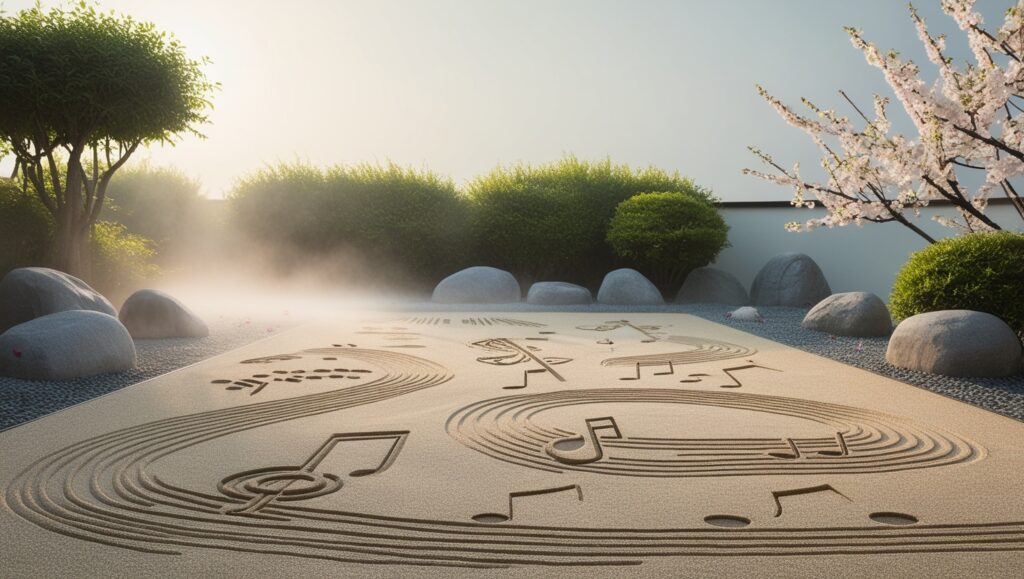In this article, we explore how mindfulness techniques can enhance your vocal practice, promote self-awareness, and lead to authentic expression through harmonious Be-ing. Singing is often celebrated as an artistic expression, a way to convey emotions, and a means of communication. However, at Vocalogy, we believe that singing can also be a powerful form of meditation. Let’s explore.
Table of Contents
ToggleMindfulness and Meditation
The Role of Mindfulness
Mindfulness is the art of being fully present in the moment, without judgment or distraction. It is more than a technique; it’s a way of being. When we practice mindfulness, we intentionally direct our attention to the present moment, observing it without judgment or distraction. It invites us to tune into our experiences, whether mundane or extraordinary, with open-hearted awareness.
Here’s what it entails:
- Present-Moment Awareness: Mindfulness invites us to notice what’s happening right now. We observe our thoughts, emotions, bodily sensations, and the world around us without judgment. By anchoring ourselves in the present, we step out of the mental time-travel that often pulls us into the past or future.
- Non-Judgmental Observation: Instead of labeling experiences as good or bad, mindfulness encourages neutrality. We become curious witnesses, accepting whatever arises. This non-judgmental stance allows us to explore our inner landscape without resistance.
- Open-Hearted Attention: Mindfulness is heart-centered. It’s about approaching life with kindness, compassion, and openness. We treat our experiences as guests, welcoming them into our awareness. This attitude extends to both meditation and everyday living.
Thich Nhat Hanh’s Wisdom
Renowned Zen master Thich Nhat Hanh reminds us that mindfulness extends beyond formal meditation sessions. He beautifully states, “The energy of mindfulness can be generated by mindful breathing, mindful walking, mindful eating, mindful washing… Everything you do in your daily life can be used for your healing.” This includes singing—each note, each breath, each vowel can become a mindful act of self-care
When applied to singing, mindfulness transforms vocal practice into a meditative journey.
Singing as Meditative Practice
Singing Mindfully: A Journey Within
‘Releasing any tension and bringing calm to your body is the first step in restoring wellness. You can’t heal your body if you don’t pay attention to it. Bringing your mind home to your body, you become established in the here and the now. You have a chance to be aware, without judgment, of any pain, tension, or suffering in your body. This is the beginning of healing.’ Thich Nhat Hanh, ‘How to Relax’
When we sing, our body becomes the instrument—a vessel through which our voice flows. Here’s how mindfulness enhances this process:
- Sensations: Mindful singers notice subtle sensations. The vibration of vocal folds, the movement of the larynx, and the movement of the diaphragm—all become tangible experiences. We become attuned to the physicality of sound production.
- Tensions: Mindfulness reveals tensions we might otherwise overlook. A clenched jaw, tight shoulders, or constricted throat—these bodily cues speak volumes. By acknowledging them, we can release unnecessary tension and allow our voices to flow freely.
- Movements: As we sing, we observe movements—the rise and fall of the breath, the articulation of consonants, and the shaping of vowels. Each movement contributes to the expressive dance of sound. Mindfulness deepens our awareness of these intricate motions.
Our brains hold an international representation of our body- a “body map“, which governs all movements, including those required for singing. By paying careful attention to our body’s responses, we understand and adjust our mental representation of the action (singing). By mapping our body’s responses accurately, we enhance neural connections. These changes lead to increased speed, flexibility, and precision in our vocal movements. It’s like fine-tuning our instrument from the inside out.
The Breath: Bridge to Mind-Body Connection
‘Your breathing should flow gracefully,
like a river, like a watersnake crossing the water, and not like a chain of rugged mountains or the gallop of a horse. To master our breath is to be in control of our bodies and minds. Each time we find ourselves dispersed and find it difficult to gain control of ourselves by different means, the method of watching the breath should always be used.‘
― Thich Nhat Hanh, The Miracle of Mindfulness: An Introduction to the Practice of Meditation
Our breath—the silent companion of our existence—often goes unnoticed amidst the hustle and bustle of modern life. Stress, deadlines, and endless tasks compound this oversight, leading to shallow, hurried breaths. Yet, within the realm of singing, our breath becomes more than mere oxygen exchange; it transforms into a bridge connecting our inner world.
Singing demands more than casual inhalations and exhalations. It requires deliberate, conscious breathing—deep and expansive. Why? Because our breath fuels our vocal instrument. Weak, strained notes indicate too little breath. Excess muscle tension indicates too much breath. Deep breathing provides the fuel that allows singers to navigate the nuances of pitch, volume, and expression
Thich Nhat Hanh eloquently describes the breath as “the bridge which connects life to consciousness, which unites your body to your thoughts.” By attending to our breath, we bridge the gap between mind and body, fostering harmony. Focusing on the breath—its rise and fall, expansion in the belly, expansion of the ribs and back—anchors us in the present. Whether in seated meditation or during singing, mindful breathing connects us to the rhythm of life.
Healing Through Singing: The Power of Relaxed Attention
In closing, remember Thich Nhat Hanh’s wisdom: “Every step, every breath, every act, can be totally relaxed—can have the power of healing… Walk as if you are kissing the Earth with your feet.” It’s not the duration or frequency of our singing practice that matters; it’s the quality of attention we bring. Singing invites us to step out of our busy lives and immerse ourselves fully in the present moment. Let your voice be a mindful melody, a healing vibration, and a bridge to inner peace.

